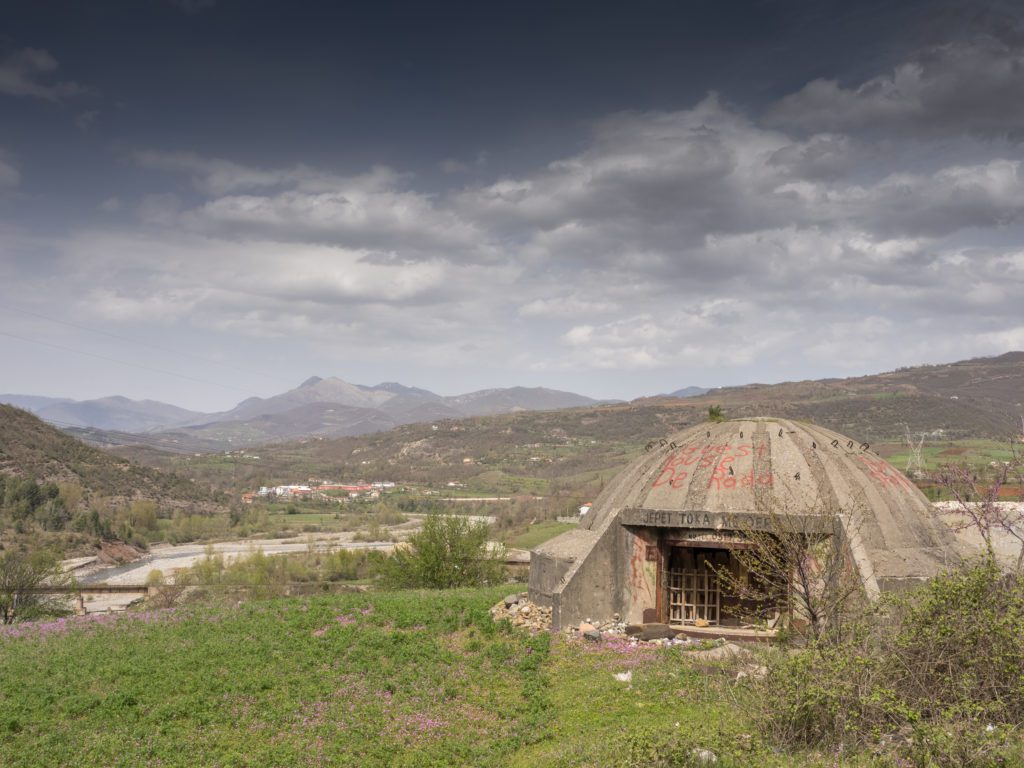During the brutal communist regime of Enver Hoxha, Albania was the most isolated and inaccessible country in Europe. For four decades, tourists couldn’t visit this little Balkan country, shrouded in an aura of mystery. It remains an off-the-beaten-track destination, but more and more foreigners make it to Albania to discover its beautiful nature. If you want to understand Albania and learn about communist history, here are some landmarks you cannot miss.

A short history of communist Albania
During World War 2, Albania was first under Italian and then German occupation. In 1944, the NLM, a communist partisan organisation, liberated it from the Germans.
Right from the start, the communists ensured nobody would stand in their way to power in the country. They didn’t play around with half-measures and assumed the most effective way to do so was to execute the members of the previous government accusing them of war crimes.
The leader of NLM, Enver Hoxha, became the prime minister of the People’s Republic of Albania.
Hoxha was a big believer in Stalinism, and some historians say he was stricter than Stalin himself.
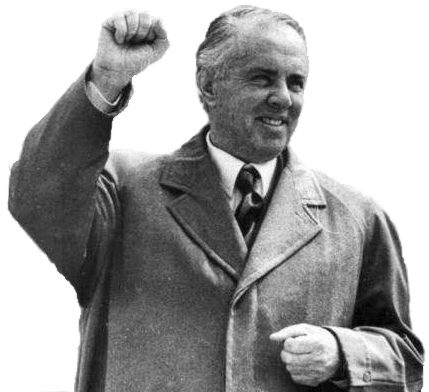
As one of the cruellest dictators in Europe, the Albanian leader didn’t hesitate to send his political enemies to work camps and jails or execute them. Between 5000 and 25000 people lost their lives because of political repression.
Communist Albania was good friends with the USSR until 1956. As the Soviets started to milden their politics and Khruschev was striving toward “peaceful coexistence” with the west, Hoxha decided the USSR wasn’t communist enough and broke the relationships with their biggest ally.
Albania entered a period of cooperation with Mao’s China, which lasted until the 1970s. Again, Hoxha didn’t like how the Chinese became too friendly with the west and couldn’t forgive Mao’s having president Nixon over for a visit.
After cutting ties with China, Albania became one of the most isolated countries on earth. It was nearly impossible to visit it as tourists and Albanians couldn’t leave either. Few attempted to cross through Lake Ohrid to Yugoslavia, risking a death sentence.
Enver Hoxha was in power for 41 years until he died in 1985. His successor, Ramiz Alia, introduced some economic reforms and slightly loosened the rules.
When the Berlin wall fell in 1989, most Albanians were still unaware of the changes elsewhere in Europe, as the state controlled the media. But the government knew they couldn’t stay in control for too long.
Despite revolts and student protests in 1990, the communist party still won the election in 1991. The protests continued, and it became clear a transformation was inevitable.
Two months after the elections, the government fell. In 1992, Sali Berisha became Albania’s first freely elected president since the 1920s.
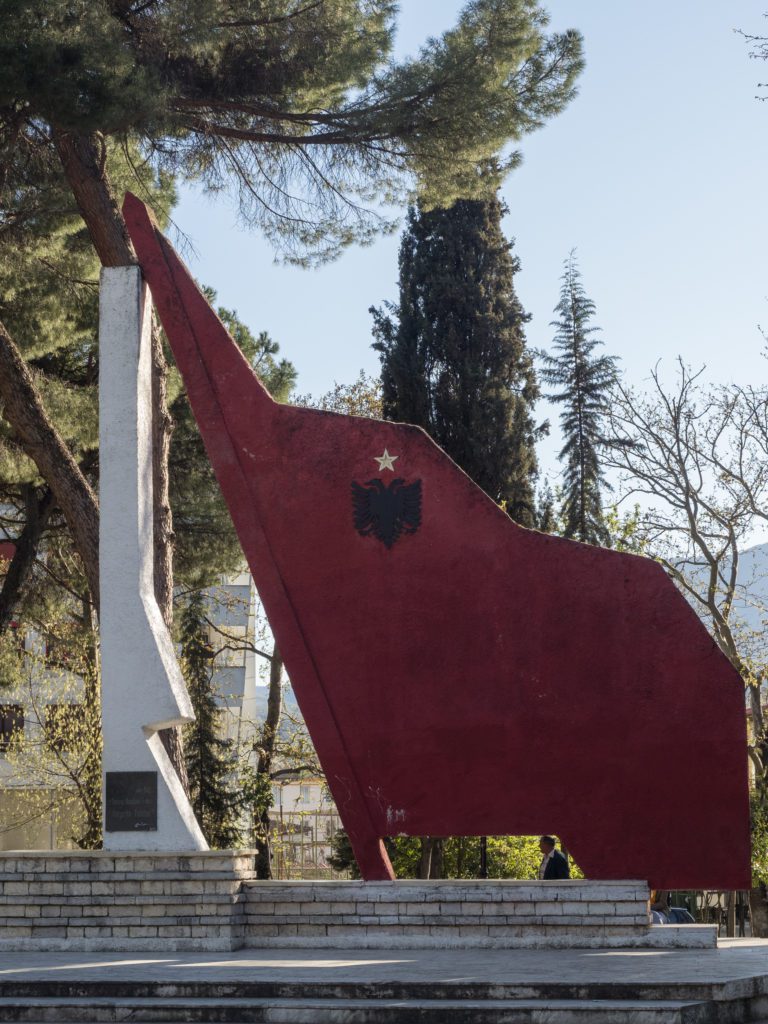
Dark tourism in Albania
Many communist sites in Albania are dark tourism sites where cruel and horrifying things have happened. Things you will see and learn about will often be disturbing and unsettling. Prepare both mentally and intellectually before you visit them.
Think twice about why you are visiting the place. Is it just curiosity, or do you actually want to understand what happened there?
Taking pictures of yourself in places where people were tortured or killed is also never a good idea.
The purpose of visiting dark tourism sites is to learn about the history and understand it better. It’s important to behave respectfully in places connected to death and tragedy.
In Albania, the trauma of the communist terror is still alive for many people.
Bunkerization of Albania
Let’s start not with one particular memorial or museum but with the most characteristic part of the Albanian landscapes – bunkers.
The ubiquitous concrete mushrooms lurk around every corner and are the favourite subject of every YouTube travel vlog about Albania.
They are the reminiscence of Enver Hoxha’s great defence project Bunkerizimit, an Albanian equivalent to the Maginot line. With one key difference: nobody ever had to use the Albanian bunkers.
After turning his back on everyone and turning Albania into one of the most isolated countries in the world ever, Enver Hoxha feared an attack could come at any time, whether from neighbouring Yugoslavia, the Soviet Union or “the imperialist West”. The project was a delusion of a paranoid dictator, and hundreds of thousands of nuclear bunkers turned out useless.
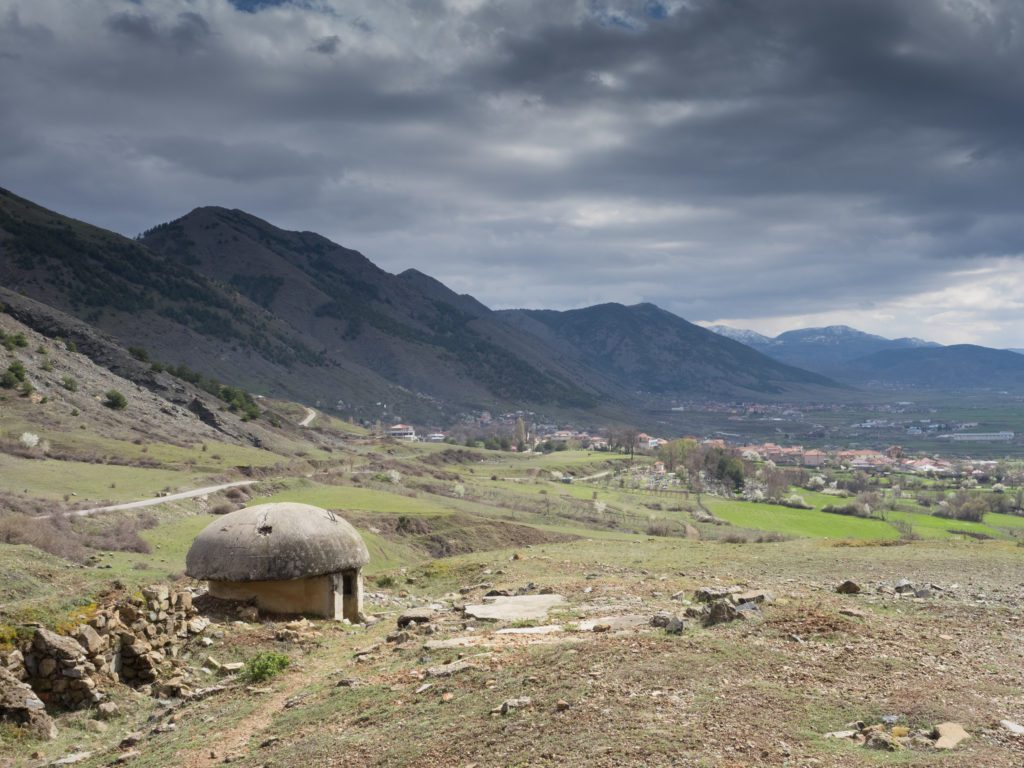
Following the regime’s fall, the question arose: what to do with the concrete bunkers? They were everywhere: in gardens, in graveyards, in the city centres, on sandy Adriatic beaches and in the middle of the mountains. Travelling through the Albanian countryside, you’ll sometimes find people keeping livestock or food in their bunkers.
Some treated the bunkers as a great source of steel. If your monthly wage is about 500 euros a month, tearing down the bunkers in your neighbourhood looks like a great business. Selling steel from one bunker for scrap can bring about 300 euros of additional income. One can demolish it in one weekend with homemade explosives.
The more entrepreneurial Albanians decided to take advantage of the bunker hype and convert the concrete mushrooms into hostels, restaurants or tattoo studios. There is even a manual explaining how you can repurpose your local bunkers into a tourism facility.
Bunk’Art Museum
Under the capital of Albania, there is a complex network of underground tunnels. Enver Hoxha commanded the construction of a gigantic bunker to protect himself and his government in case of a nuclear attack.
In 2014, the bunker became a museum and art gallery – Bunk’Art. If you first arrive in Albania and know nothing about its history, I recommend starting there.

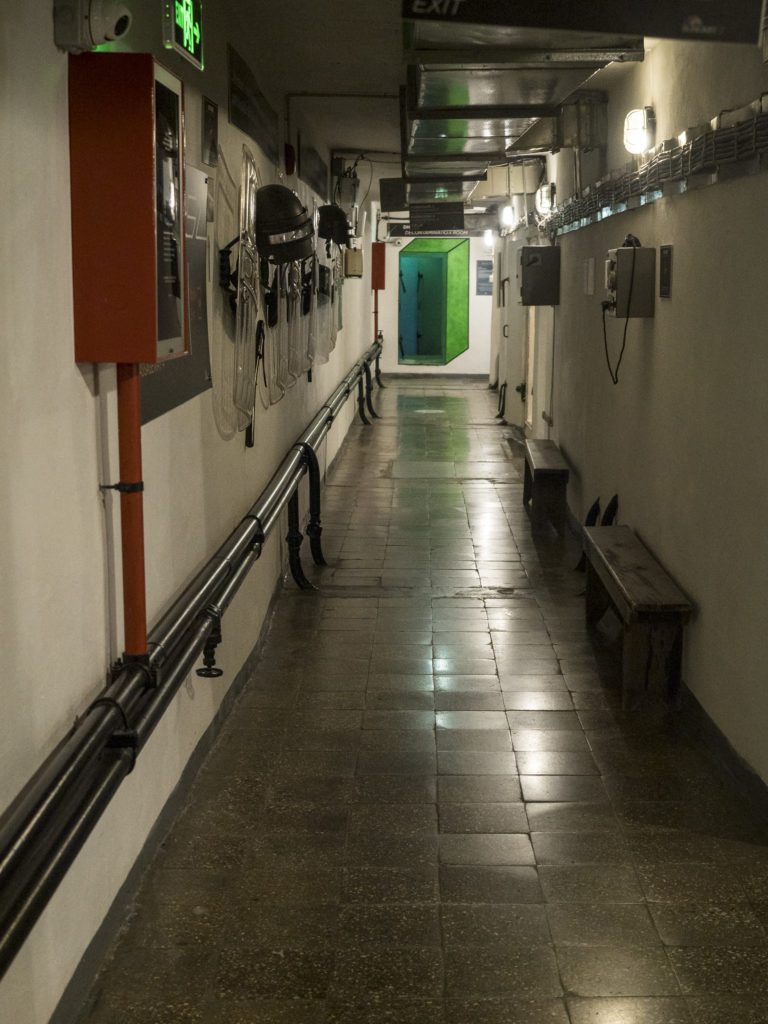
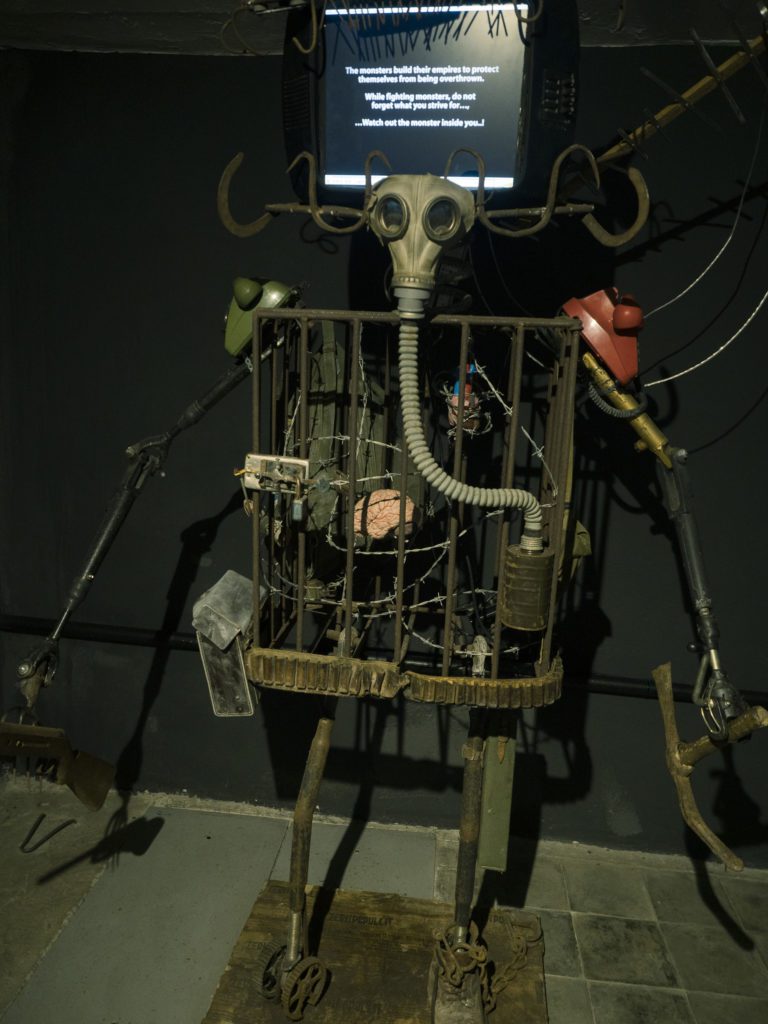
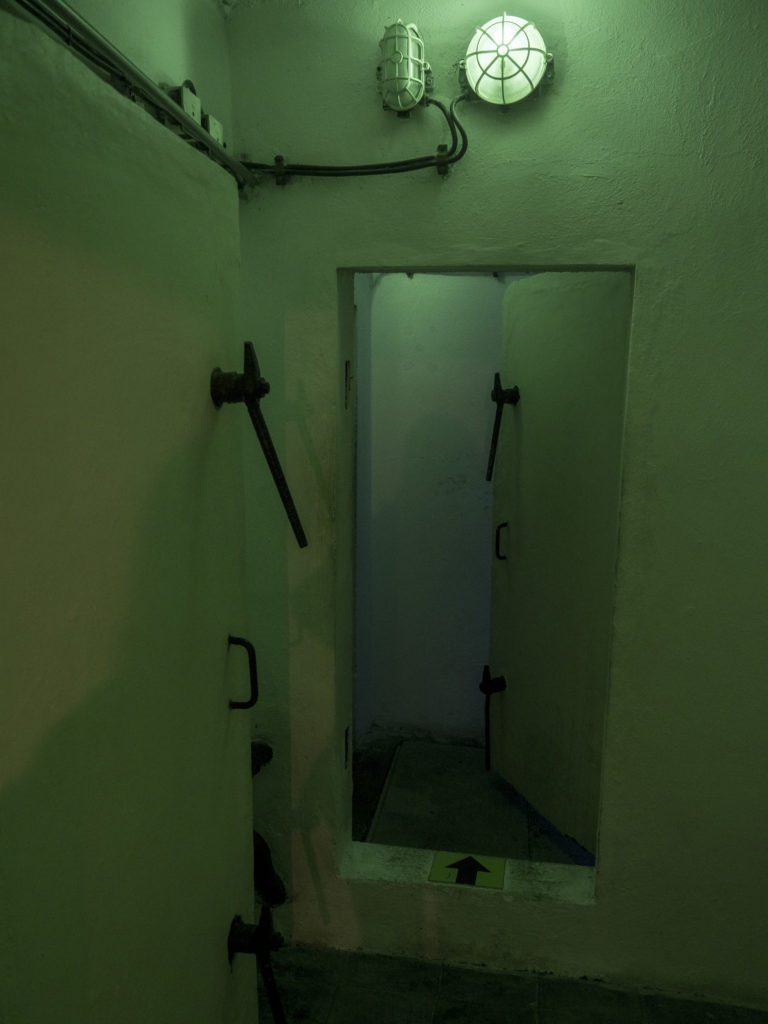
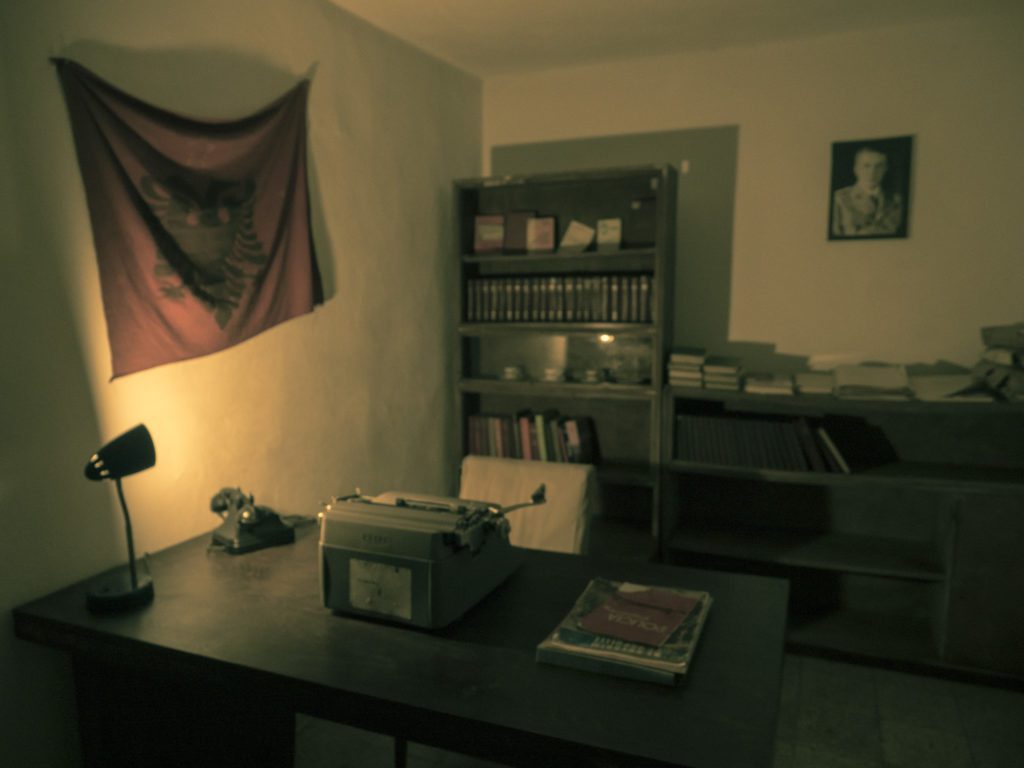
There are two parts of the museum – Bunk’Art 1 and Bunk’Art 2. The first one is located further from the city centre, near Dajti Cable Car. The exposition in Bunk’Art 1 is a more general story about communism in Albania.
Bunk’Art 2 is easier accessible, right next to Tirana’s main square – The Skanderberg Square. This museum is smaller, with the exposition focusing more on the darkest sides of Hoxha’s regime – the labour camps, torture, surveillance and the secret police Sigurimi.
Statue of Mother Albania
The national mothers’ statues were quite a trend in the Eastern Bloc. The monuments of strong and dignified watch the cities of Kiyv, Tbilisi and Erevan. Tirana has its own maternal figure – Mother Albania. A 12-metre-high concrete statue built in 1971 overlooks The National Martyrs Cemetary, the burial place of soldiers who died in World War II.
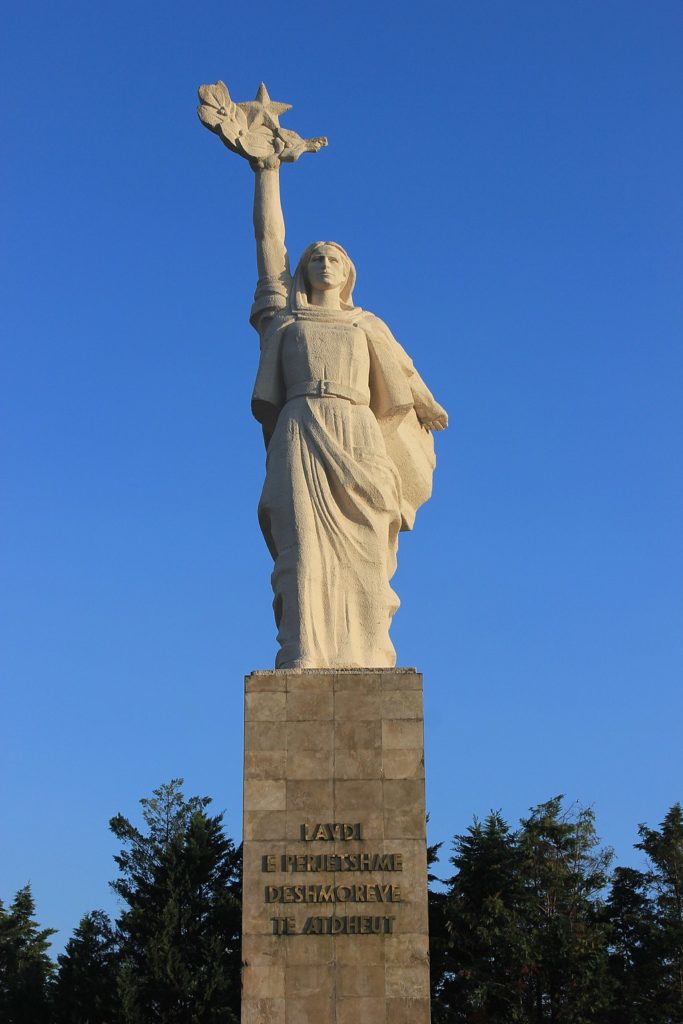
Pyramid of Tirana
Currently (November 2022), it’s unfortunately not possible to visit the Pyramid of Tirana because of renovation works.
The Pyramid of Tirana is the most characteristic building in Tirana and one of Europe’s most famous brutalist buildings. One of the architects behind it was Enver Hoxha’s daughter Pranvera.
Some people used to call the Pyramid of Tirana Hoxha’s mausoleum, although there was never a plan to bury the dictator there. The purpose of the building was, however, the museum to the communist ruler.
The museum didn’t survive long, as only three years after its opening, the communist regime collapsed.
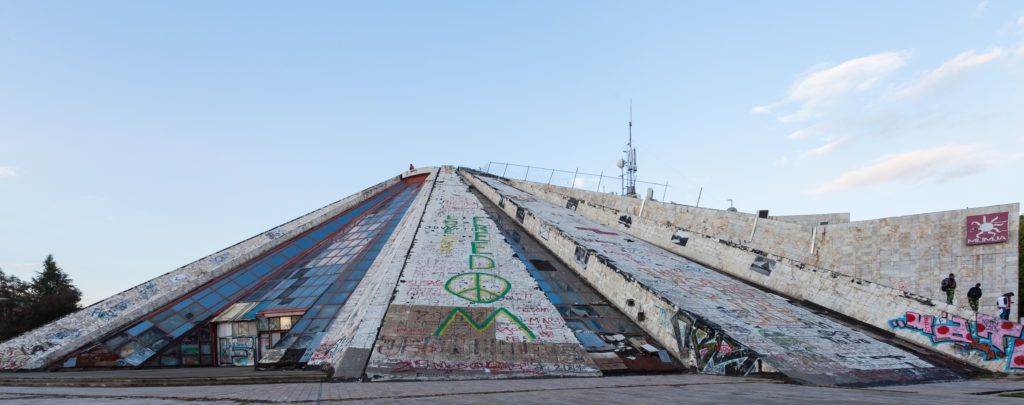
For many years the pyramid was where the local youth hung out, and kids used the pyramid walls as slides.
During the Kosovo War in 1999, the pyramid served as a NATO base.
There were many controversies about what to do with this symbol of the oppressive regime. In the end, the residents of Tirana decided to reclaim the pyramid as their own space.
Jeśli chcesz przy okazji odwiedzić Finlandię, project of a Dutch architect studio MVRDV will give the pyramid a refreshed and more modern look, which might be disappointing for the enthusiasts of brutalist architecture.
House of Leaves
Innocent-looking red-brick building with cute blue shutters and a facade covered by ivy leaves was a witness to the Albanian state’s psychological violence and oppression towards its citizens.
It was the HG of the Sigurimi – Albanian equivalent to KGB or Stasi, with no less cruel methods. The secret police ensured everyone with even the slightest ties to “the enemies of the state” would be kept under surveillance and repressed.
If your cousin, uncle or grandfather had views not in line with the party’s ideology, you could forget about getting into university or getting a job you wanted.
Currently, the building of House of Leaves holds a detailed exposition of various aspects of Sigurimi’s work. It explains the bugs and technical gear used for surveillance, as well as the complex structure of spies, agents and collaborators that made people in Albania afraid of saying anything and spread mistrust among each other.
Victims’ testimonies on torture and interrogation are very unsettling and disturbing.
National Art Gallery (and particularly behind it)
The times when you could see the statues of Lenin and Stalin in Albania’s squares and streets are long gone, but you can still find the figures of the Soviet leaders behind the National Art Gallery. In the garden, you will also find a ZIS car, commonly used by the Sigurimi – the secret police in communist Albania.
The Gallery is currently closed for renovation.
Other communist landmarks in Tirana
- The facade of The Albanian National Museum on Skanderberg Square
- The bas-relief on the government building at Rruga Ismail Qemali
- Enver Hoxha’s residence (not open to the public)
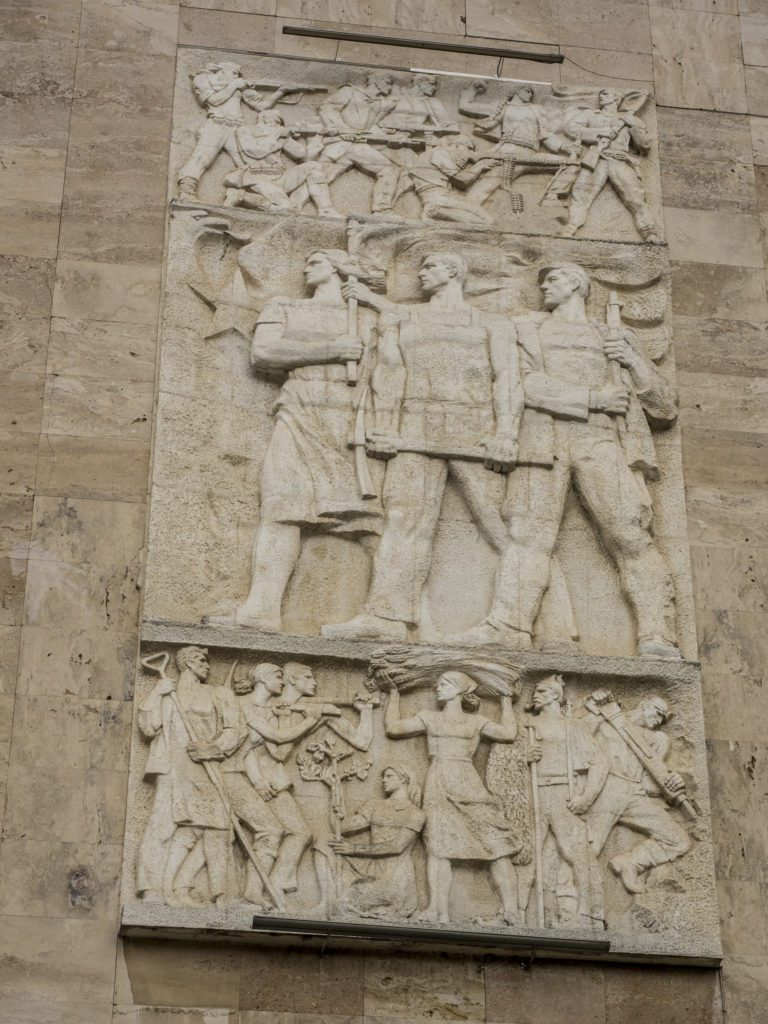
The Shpiragu mountain near Berat (The Never-mountain)
You know you live in a crazy dictatorship when you can see the name and the leader’s face everywhere.
The cult of personality in Albania was at least as strong as in the USSR. They had plenty of statues of Enver Hoxha, and in Berat, you could also see his name on the slope of the Shpiragu mountains.
Each letter was 100 metres high, and the residents of nearby villages were forced to paint them as a gift for Hoxha’s birthday. For years after his death, the locals had to look at the letters ENVER that reminded them of the merciless dictator. They were visible from many kilometres.
In 2012, Sheme Filja, a local farmer, replaced the letters N and E, creating the word NEVER. This act was a protest against communism ever coming back and a complaint about slow progress in Albania after the political transformation.
Cold War Tunnel in Gjirokaster
In his hometown, Enver Hoxha ordered the building of an underground tunnel with 80 rooms for the local officials and VIPs to hide in case of a nuclear attack. The project was secret, and most locals didn’t know what was hidden under the town of Gjirokaster until the regime fell in 1991.
In a contrast to Bunk’Art museums, the nuclear bunker under the castle of Gjirokaster remains in a condition similar to the original. It leaves space for imagining what it was like to be there during the Cold War. Some equipment was looted during the unrest in 1997. You can still see the original Czech power generator and furniture in the offices or conference room.
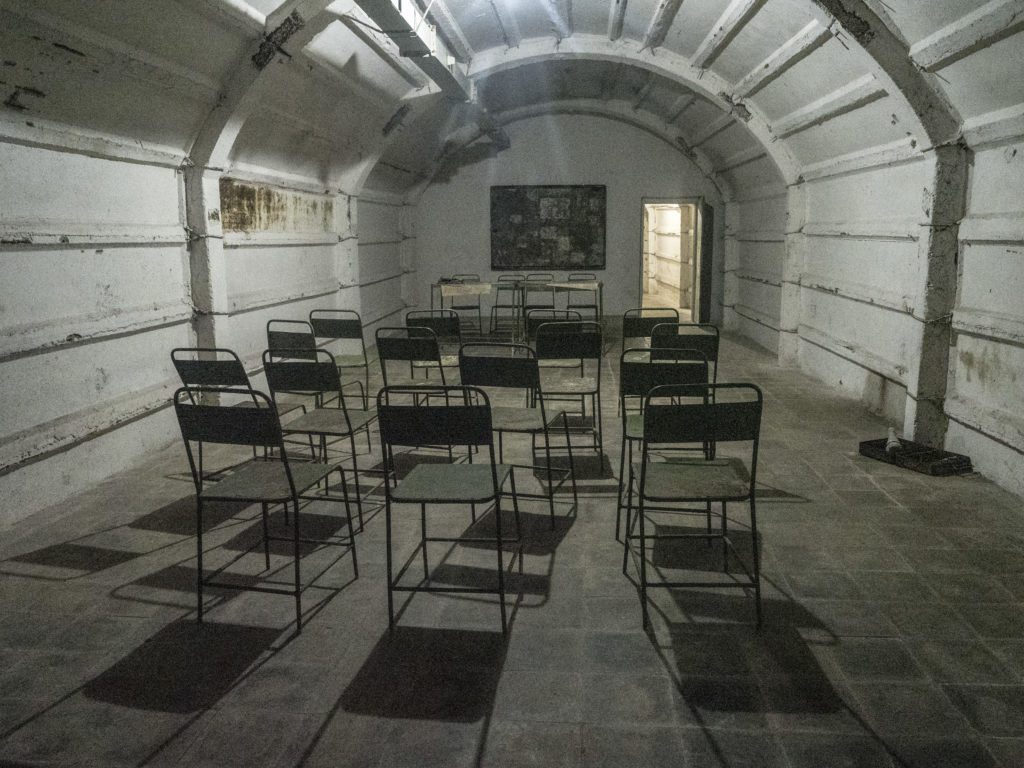
Spaç Prison
In the remote mountains near the village of Spaç, there is an abandoned prison. Its political inmates there were forced to work in a mine. The work conditions were primitive and dangerous, and the prisoners who didn’t fulfil the unrealistic quotas were tortured.
In 1973, the prisoners started an uprising against the regime, but the guards brutally quashed the rebellion.
Today, the building of one of the cruellest Albanian prisons is in a state of deterioration, but you can still see some communist slogans and prisoner drawings on the wall.
The trip to the site is strenuous, with a bendy dirt road. It allows you to grasp the effort and despair of the families who walked there for hours only to hear they couldn’t see their beloved ones because of a guard’s whim.
There are some information boards in English, but to best understand the history of Spaç Prison, it’s best to visit with a local guide.
Antique Shop on Kruje Bazaar
If you collect communist memorabilia, you must visit one antique shop at Kruje Bazaar. I found it by chance, and it was one of the most exciting discoveries of my month-long trip to Albania.
You’ll easily spot it among shops selling carpets and other Albanian souvenirs. Just look for the shop window with book covers with Lenin and Stalin.
The shopkeeper is very kind and speaks pretty good English, and he’s keen to explain the meaning of the items, like the badges for the best worker or the best soldier.
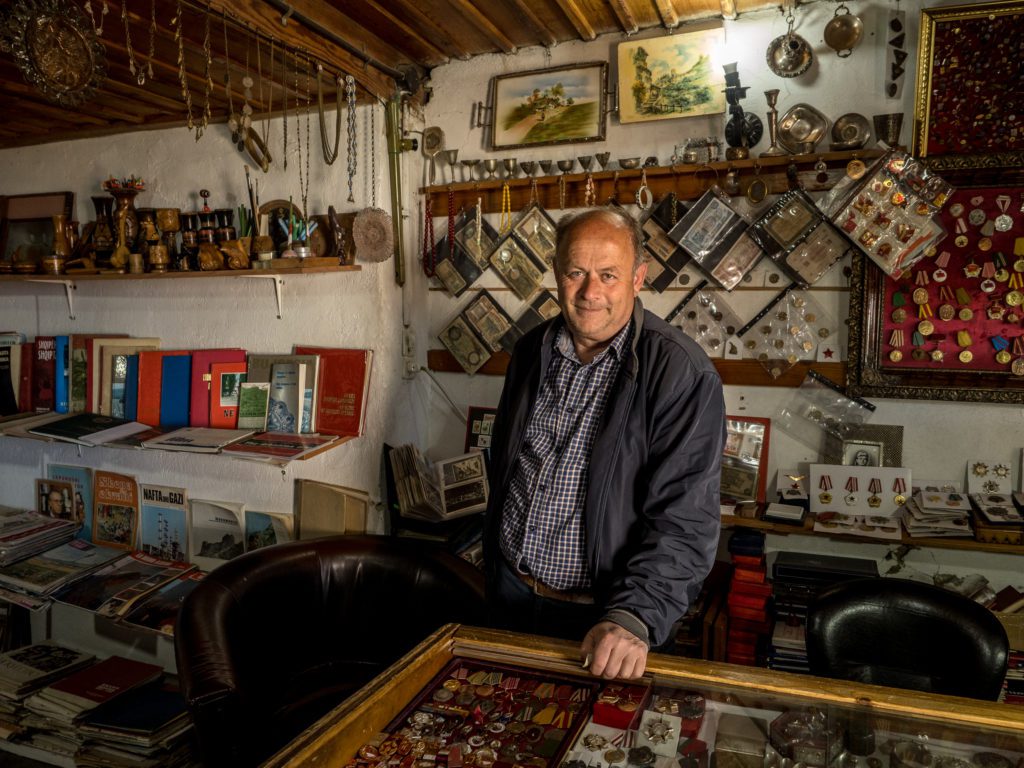
You’ll also find plenty of books about the history of communist Albania and postcards from that time. If you’re looking for authentic communist souvenirs from Albania and not a tacky mug with the face of Enver Hoxha, the shop at Kruje Bazaar is the place to go.
The Steel of the Party – the industrial centre of communist Albania
Elbasan and the neighbouring Librazhd, Prrenjas and Pogradec are great places for urbex in Albania. Kombinati Metalurgijk, Albania’s industrial centre, was built in the 60s by the Chinese (that was still when Hoxha and Mao were good friends). The metallurgical plant was called The Steel of The Party.
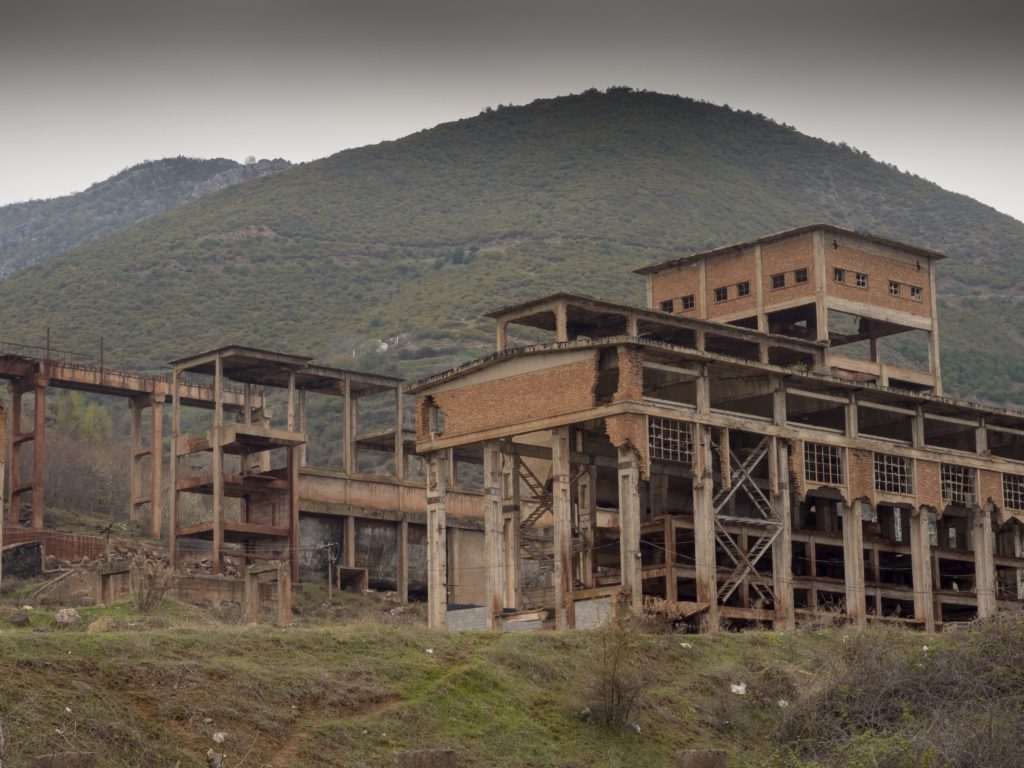
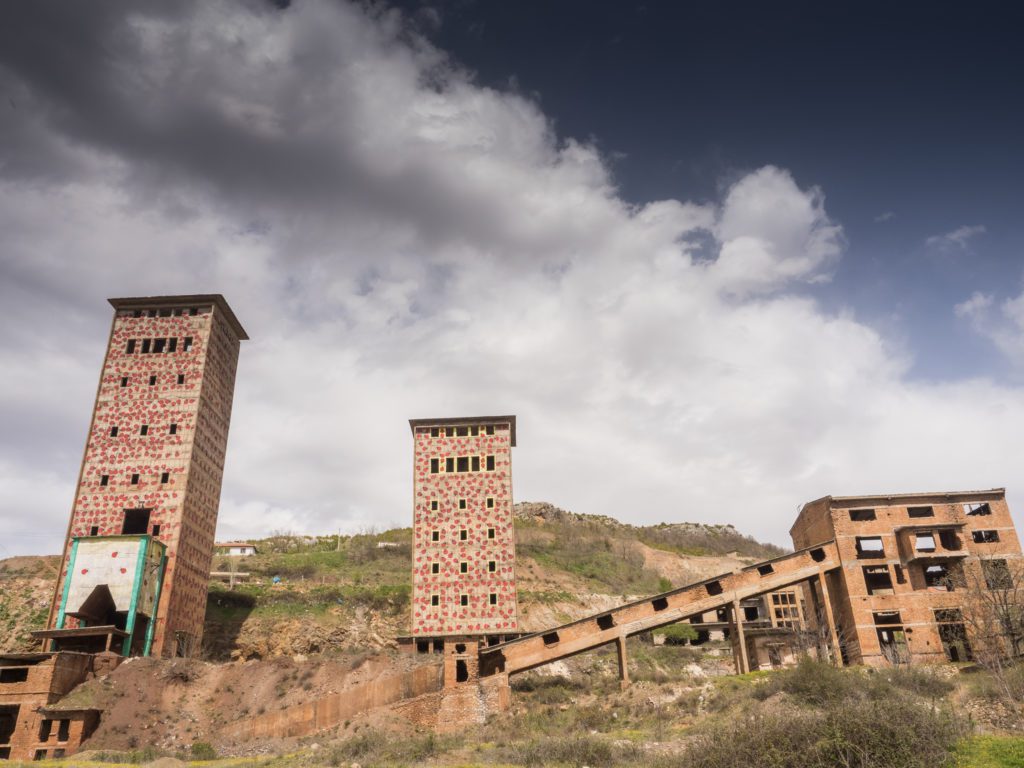
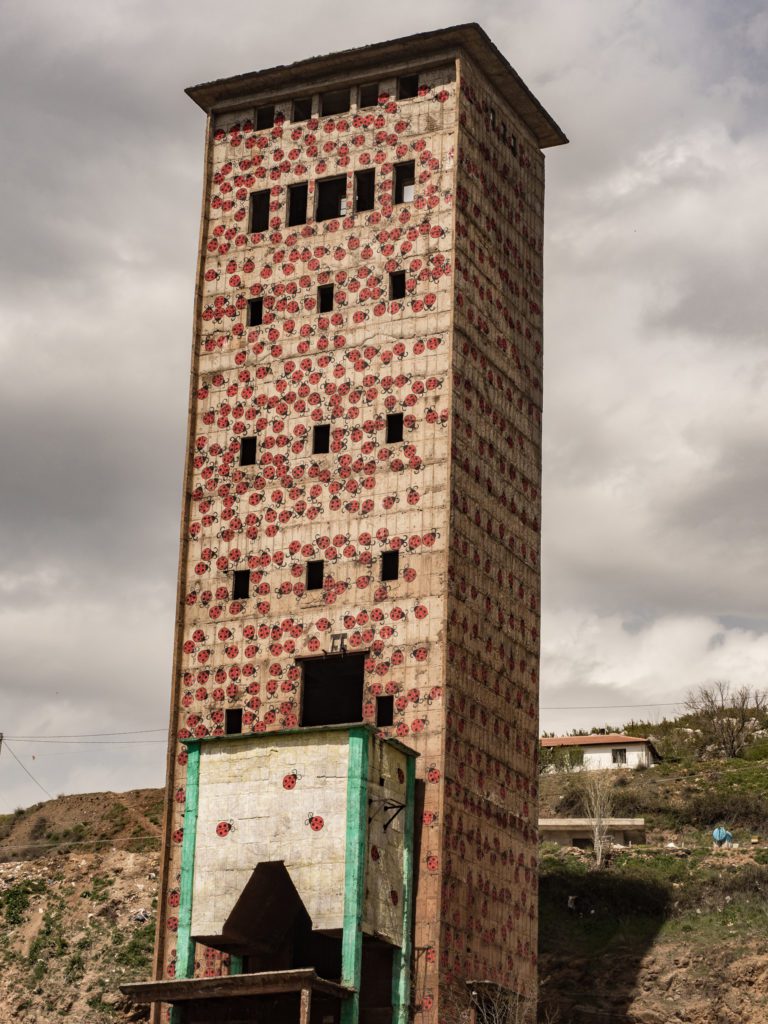

There are a lot of abandoned factories south of Elbasan for the urbex fans. The factory in Elbasan is still working, and the city is known as the most polluted city in Albania. During communism, the fumes polluted the air, and even today, heavy metals contaminate the soil.
The current factory has the filters installed, but they sometimes turn them off to save money. Air pollution in Elbasan is ten times higher than the threshold tolerance in the EU. Every year, 250 people die of cancer there. There are also reports of genetic mutations, like malformed babies or goats with two heads.
Site of Witness and Memory Museum, Shkoder
If you’re staying in Northern Albania, visit the Site of Witness and Memory Museum, the first memorial to the victims of communism in Albania.
During Hoxha’s regime, Shkoder was a city of prisons, with 23 facilities where “the enemies of the state” were persecuted and tortured.
The collection in Shkoder is small, but the artefacts donated by former prisoners tell a moving story about the terror of Hoxha’s state and help understand Albania’s modern history.
